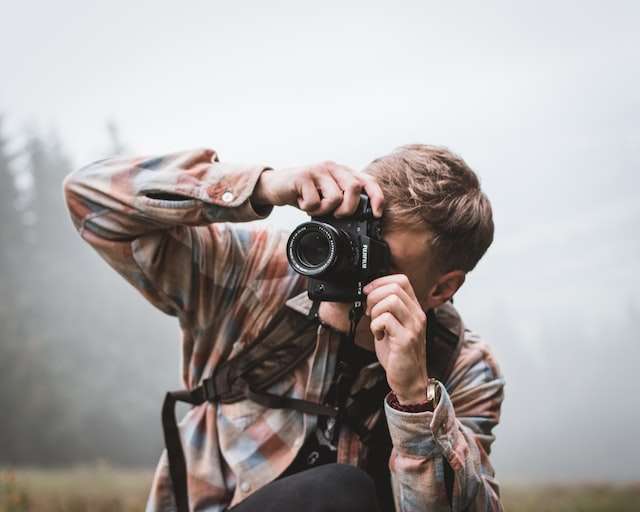Having the best camera strap for hiking and outdoors makes photography much easier than opening and pulling the camera from the bag whenever you want to take a photo. Undoubtedly, the best hiking cameras are expensive, and we should keep them safe during hiking or trekking. Neck or wrist straps perform well when you want to comfortably hold your camera.
Neck straps are rope-like structures made with robust and comfortable material. They have sturdy clips attached to them to get tightly hooked in. While wrist straps are also the same, their size is different. And wrist straps are suitable for those who don’t like cameras hanging around their neck. They may be more style free. Thus leaving no space for risks. And then you can freely mount the cliffs and capture your best scenes.
So, to help you pursue your photography dreams without any unexpected and unwanted events, we have created a list of the top 5 best neck and wrist straps. In addition, we also have discussed some commonly faced neck strap challenges and their solutions.
Best Overall Camera Straps For Hiking
1. Peak Design Slide Lite Strap
Peak Design Slide Lite Camera Strap is the best and most highly rated camera strap with four straps and a plate for attaching to the base of your camera. It comes in two different types in terms of thickness.
Moreover, this is one of the sturdiest straps from a top-tier brand Peak Design. The well-made anchors provide a secure layer between your neck and the camera. Also, it won’t even break accidentally due to its high quality and durable material. This is an excellent option if you have small mirrorless cameras and DSLRs.
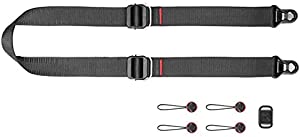
Additionally, you can remove and replace the belt in seconds and even while on the go on trails. Button straps connect easily to the camera and look much more durable than most other brands we explored. They look more practical than a few different straps on the market.
In addition, if you hike a lot or climb rocky mountains to get the best view of the rushing waterfalls, this is your swaying camera’s perfect savior. So, with the help of this durable and versatile camera strap, your camera will stay in place rather than swing to and forth. It’s also easy to shorten the length.
This strap will eradicate your previous problem of fighting with the installment of heavy anchor point clips. Then another bonus feature is its rubber-like grip, which acts as a stopper for the slipping camera/strap.

Moreover, you can configure it as a sling and a side strap for comfort. And it not just provides different carrying styles but also takes very little time to swap the style. Since this is simple and straightforward, you can change from using it as a sling strap to a shoulder strap in seconds.
In addition, if you hike a lot or climb rocky mountains to get the best view of the rushing waterfalls, this is your swaying camera’s perfect savior. So, with the help of this durable and versatile camera strap, your camera will stay in place rather than swing to and forth. It’s also easy to shorten the length.
However, these straps get a little uncomfortable if worn longer. This is mainly due to the strap being slim. But don’t worry. It only happens if used with a heavier camera. Moreover, the strap gets annoying when using the strap (both thick and thin) in a cross-body style. Usually, it bothers by getting in the way of the screen, whether folded or opened.
Also, the anchor points are rigid plastic, contributing to their weight. This causes the anchor links to fall by themselves and also causes friction while rubbing against the camera’s body. And this doesn’t go well, as it blesses the camera with scratches. It would be better to follow the precaution by excluding the strap when packing the camera into a bag. Remember, the plastic is more rigorous than the camera’s body.
Pros
- Excellent quality
- Highly durable
- Easy to use
- Prevent the camera from swinging
- Has grip to stay on the shoulder
Cons
- Pricy
- Anchor points may leave scratches if not removed when packed
Best Wrist Strap Option
2. Peak Design Cuff Wrist Strap
Peak Design Cuff Camera Strap is a high-quality wrist strap that is comfortable. It uses robust and easily released clips while pressing the button and maintaining the camera’s security.
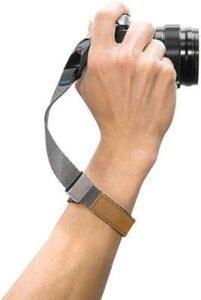
This strap reflects a funky look and also possesses sharp functionality. The top thing is that it comes at a reasonable price to satisfy those who hate carrying their camera hung to their neck.
Moreover, the packaging and design are top-notch. Due to its excellent versatility, the quick releasement of anchor points aids in shifting the strap from one camera to another within seconds. Also, two anchor points allow connecting the strap to more than one body. If you are using a tripod, then this strap helps you stabilize the steadiness when sliding the belt’s body off.
Furthermore, when you are not using the camera strap for work, its magnet gives off a bracelet look that simultaneously seems decent. It is super easy to attach and detach from the camera.
However, the camera may fall on the ground if you have larger hands. The decent-looking metal band that you can also use as a strap loop has edges that may be annoying. The reason is that these edges may distort the camera’s body, LCD, or other devices.
When walking, you cannot loosen your grip on the camera because it will be swinging here and there, plus strangling and weighing down your wrist. Heavier equipment, like cameras/lenses, can get tight on your wrist. Another minor flaw is that the strap, specifically the silver one, has a permanent mark created by the magnet; now, this mark created was a square of worn leather.
Pros
- Easy to wear
- Compatible with a camera on tripod
- Sturdy
- Best for those who don’t like neck straps
Cons
- Not suitable for heavy cameras
- Not for big hands
Best Budget Friendly Option
3. Art Tribute Vintage Camera Strap
Art Tribute Vintage Camera Strap gives your camera a great look and artistic touch. It drives away the boringness of traditional straps. It’s splendid in shades and patterns. This strap is very sturdy. Although it looks large, it works with tiny blog cameras.
In addition, if you have a Canon G7x or other miniature camera owner, this strap can work through the larger strap because of the small and workable clasps. It may be a bit longer, but it is completely adjustable with the straps.
The strap is sleek and smooth, so it doesn’t rub against your skin. No matter how heavy the camera is, the strap adorns it with great functionality. This strap won’t let your camera put a burden on you.
Moreover, it’s easy to install and has a great design. But more importantly, if your camera has tiny eyelets that don’t work well with the strap’s ends, it would be more secure if you purchased some clips with your new strap.
Its downside is that the connectors immediately release when pressed. And the strap doesn’t have much agility as it’s simply a piece of nylon thread with knots tied in to attach with the plastic clip. Hence, it may have security issues, which should be considered. Durability might be a concern here, but it comes cheaply and affordable.
Pros
- Artistic look
- Long and wide strap
- Can fit tiny cameras
- Easy to install
- Very comfortable
Cons
- Not long lasting
- Not the best choice on backpacking
4. TARION Camera Neck Strap
You probably won’t want to be perceived merely as a tourist. You would desire to blend with the crowd and Look like a professional photographer. You have also likely taken your next step towards becoming a pro photographer. Then this stylish and comfortable alternative to the standard camera straps is the best purchase for you.
This is an upgraded version of the TARION strap, which features great security with the addition of a new buckle. Hence, now you are less likely to have camera accidents.
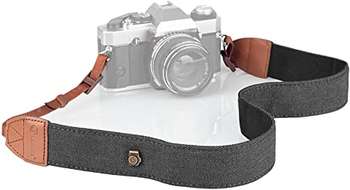
The belt has got an excellent texture to the material. It’s subtle yet feels strong enough, and it will sustain falls. Thus, you don’t have to worry about dropping your camera. Moreover, this strap has a little brass camera pin reflecting comeliness. It even fits on keyrings. The quality scale is marked by the degree of high standards.
This robust strap remarkably bears harsh weather and sun pretty well. Next, it’s built to accomplish tasks of carrying heavier cameras. It also has clear and well-defined instructions on how to set the strap up. Besides, the method shown is a very unique and easy one.
Although the metal clips seem sturdy, most users have reported it’s slippery. It slips through the clasps that are supposed to secure it. Also, the strap needs to be of more width. However, this comfortable and elegant strap will gain great points in maintaining cleanliness.
Pros
- Stylish look
- Very robust
- Best for heavy work
- Comfortable
- Affordable
Cons
- No padding
- Not wide
Best For Underarm
5. BlackRapid Curve Breathe Camera Sling
This is the most suitable option for those with neck injuries. It’s more comfortable than a regular around-the-neck camera strap. BlackRapid Curve Breathe Camera Sling is more secure than carrying the camera over the shoulder.
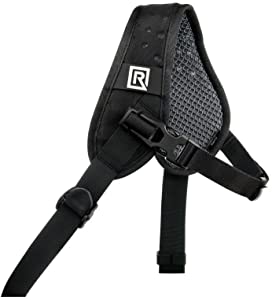
You can quickly get the camera into shooting position from the hands-off side hanging position. The sling is so easy to use and super comfortable.
Moreover, it’s sturdier and better made. There is no uncomfortable neck strap chafing. Hence, you would barely feel the camera on your shoulder. This innovative design quickly locks the camera into position and stays fit. Thus, no more swinging forward. Also, the camera slides over the strap smoothly whenever a quick shot is intended. And the camera hangs the lens down when not in use.
However, we don’t like to unscrew the strap every time a tripod is used. As a result, you may have to purchase a Manfrotto tripod mount screw. This way, you can keep the tripod plate on the camera and the strap attached to the plate. So, swapping from belt to tripod will be easier.
It would help if you constantly put the camera over your shoulder when carrying it and then take it off for a shot. And whenever bending, the camera would swing forward.
Also, getting high or very low shots is only possible if you have made the strap length. So low or high perspectives may require you to disconnect the strap, which is not easy or quick.
Pros
- Secure design
- best for those with neck injuries
- Comfortable
Cons
- Have to take off every time when to click a shot
- A bit pricey
Camera Straps Challenges and Solutions
If you are an enthusiastic hiker or backpacker who delves into the beauty of natural scenes and who doesn’t want to let go of these moments, then you are someone who knows the importance of a camera neck strap. And having a neck strap is not the only thing. It must be the most reliable and comfortable one.
A camera strap is a straightforward gadget, so it’s hard to figure out what may make it harmful. Sometimes neck or camera straps can indeed be tiring rather than beneficial.
Here we will discuss some common neck strap challenges that ruin your enjoyment of photography or build the fear of taking a camera with you on hiking trips.
Challenges
A traditional neck strap is a standard option for most cameras. It’s simple, inexpensive, and provides the necessary security for your camera. However, it has constraints too.
- It causes discomfort when worn for a much longer time.
- The constant swinging of the camera can lead to damage, and the strap can dig into your neck, causing intense pain.
- It even keeps banging on your ribs, and after a while, it hurts.
- A sweaty neck strap can be frustrating, especially during hot weather. Vulnerability of being attacked by thieves. Sometimes neck straps have exquisite colors or logos, but these effortlessly linger the attention of thieves. In essence, camera straps impose security issues too.
- Finding a strap that is not too visible and of quality at the same time is tricky.
Furthermore, body slings, marketed as an alternative to neck straps, are essentially long neck straps that shift the discomfort to one shoulder at a time. They can be more comfortable than neck straps but can limit mobility when using a backpack on the camera strap. For instance, the BlackRapid Backpack Camera Sling attempts to solve the discomfort issue by connecting to your bag, but it still doesn’t address the swinging problem.
On the other hand, camera holsters and harnesses provide a more ergonomic solution by not resting on your neck or a single shoulder. However, they are often bulky and can become soaked with sweat during a hike or backpacking trip. Besides, when you need to grab your camera in a rush, camera holsters and harnesses also impose constraints here.
So, what’s the Solution?
Ditch the neck strap altogether and opt for a hands-free option. A camera clip or wrist strap can provide the necessary security without adding discomfort or limiting mobility. In addition, they offer easy-peasy access when you want to click a shot within seconds.
A camera clip attaches to your backpack, belt, or clothing, providing a secure, hands-free way to carry your camera.
It keeps your camera close to your body, reducing the risk of damage due to swinging. This handy gadget is also a solution to the interruption of grabbing a camera to take valuable shots on time. Plus, some camera clips have quick-release mechanisms that allow you to detach your camera quickly and efficiently.
Best Clips For Straps
1. Peak Design Anchor Links for Camera Straps
Peak Design Anchor Links are widely famous among photographers who want to take photos while on the go. Sometimes when you use a camera strap on a tripod, it acts like a flag in the wind. And this isn’t very pleasant. It ditches your focus from work. So, these anchor links are excellent for quickly removing the strap for stability and reduced movement if it’s a bit windy when using a tripod.
Plus, taking neck straps off is time consuming. So, Peak Design Anchor links are a great alternative. Also, you can take the belt off in seconds with these.
Moreover, this handy piece lets you quickly switch between a wrist or neck strap. These little connectors attach nicely to many camera straps made by other brands. They are far more reliable than the plastic snap connectors most brands use.
There are a lot of brands out in the market that has great straps for tall people. But for short people, they are frustratingly long. Ultimately, if you are one of those people, you will find these Peak Design accessories very useful. The clips and attachments click together reassuringly and feel very solid.
The only drawback is its high price for what it is. However, it is worth paying for a trustworthy system – not worth the risk of a cheaper but inferior product when your expensive camera’s life depends on it.
Pros
- Easy to attach and detach
- Durable
- High security level
- Can switch between a neck strap or a wrist strap
Cons
- Expensive
2. Peak Design – Capture Camera Clip
If you are constantly hiking around with couples on their wedding day or weary at hikes and don’t want your camera hanging around, this is your hands-free and highly reliable clip buddy. This clip ensures the ease of accessing your cameras without compromising the camera’s safety. The built quality is top-notch. The ease of use is superb. The ability to clip the camera sideways and change the lens with one hand only is incredible.
Furthermore, this prevents the camera from dangling and causing discomfort. No matter what the size of the lens is, this will make the camera sit firmly. Lastly, these peak design capture camera V3 clips will remove the problem of the camera strap interfering with your sling bag strap.
The only downside to this clip is it is not Arca-Swiss compatible. Arca-Swiss is for video rigs, and the peak design ecosystem is strictly for photography. Moreover, the clip does not fit any shoulder strap; For example, BCA Stash 40, Deuter 65 Liter, BCA Float 32, Deuter 24 Liter, Burton Focus (designed for camera gear), and e EVOC Camera Backpack. It does not fit any of them. All the outdoor backpacks have Shoulder straps wider than 6,4 cm.
Additionally, most shoulder straps are too thick, so it is not for you if you are a mountaineer.
However, if you are an urban photographer, wedding photographer, or similar with smaller backpacks, it’s the best safety tool in the market.
How To Choose Camera Straps: Buying Guide
Material
Nylon: Nylon is a popular material for camera straps due to its strength and durability. Moreover, it’s light and tricky to clean. But some people find nylon straps unsuitable because they cause discomfort when they wear them for extended periods.
Leather: Leather is a classic material for camera straps, without any doubt. These are mainly more comfortable due to leather softness than nylon but are comparatively expensive.
Neoprene is a manufactured rubber material that is not bad. It is usually soft and more stretchy compared to others.
Cotton: Cotton is a natural, comfortable material often used for more casual or fashionable camera straps. However, It may not be suitable for heavy use or for bigger cameras
Paracord: It is often used for outdoor or adventure photography as it can withstand harsh conditions. So it provides good advantage
Comfort
You cannot compromise the comfort of hiking camera straps. Of course, you don’t want to suffer from neck injuries while hiking or backpacking. However, it becomes more critical when it comes to backpacking, where you hike for days.
The material of the camera strap determines the quality and comfort of the strap. We have discussed different materials and the benefit of each of them. The most popular soft materials are nylon and neoprene. You should select a belt made of soft which doesn’t rub against your skin.
Also, look for a strap with a broader length, as it will distribute the weight of your camera more evenly across your shoulder or neck, reducing the pressure and strain on a single area.
Another factor to consider is the adjustability and design of the strap. A well-designed strap will distribute weight evenly.
Security
The material of the strap should have the power to withstand the weight of the hiking camera without stretching much and breaking. And it should be tear-free. This is especially important if you use a heavier camera mainly. Always look for a solid material and quality strap if you want to use it for extensive hiking and outdoors. This way, your camera won’t fall. Even the strap gets stuck somewhere and gets pulled.
Moreover, straps come with fixed locks designed to secure the camera. These locks prevent snatchers from pulling off the camera. These locks can be key-operated or have a combination lock. Locks add an extra layer of security to prevent theft.
Leather straps are better due to durability and strength. And they won’t break it easily if someone tries to snatch it.
A non-slip or grippy material is particularly useful for shoulder or neck straps that support heavy or bulky items such as backpacks and camera bags.
Another advantage of an anti-slip feature is that it can help redistribute weight evenly across the shoulder or neck.
Weight
One of the critical considerations is weight, as a heavy camera strap can cause discomfort and even pain after prolonged use. Hence, opt for a lightweight belt. A lightweight camera strap can offer several benefits, including increased comfort and reduced strain on your body.
In addition to being more comfortable, a lightweight camera strap can be more practical.
That said, it is important to consider durability when choosing a lightweight camera strap. However, a lightweight strap is not convenient in every situation.
If you plan to photograph in more rugged environments, for instance, in crowded places, on the station, while hiking, or to climb cliffy areas, you must look for a heavier and more durable one.
Attachment points
There are two common attachment points which are the tripod mount and the strap lugs. The tripod mount is the hole on the bottom of your camera that attaches a tripod. Many camera straps attach to this mount using a metal or plastic plate. The strap lugs are the small metal loops on the sides of your camera designed to hold a camera strap.
Some camera straps attach directly to these lugs using metal clips or rings, while others use loops or buckles to connect to the lugs. Indeed, this type of attachment may not be secure as a tripod-mount attachment. However, it allows a quick attachment and detachment of the strap.
Summary
Camera straps are essential when taking photos easily while on the trail. Based on our experiences, industry experts’ opinions, and fellow hiker’s reviews, we shortlisted the best camera straps for hiking and outdoors, along with the buying guide and various tips.
